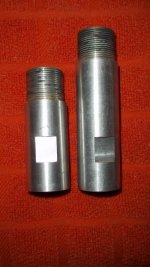V
Vibe
Guest
My thinking is that sooner or later investigative people like you, Al and Geoff (and a few others) will find that todays tuner designs do not really have any "Adjustments" that truly affect the variables that would make a truly adjustable tuner. Those that didn't get hung up accepting the fantasy theory are getting closer, but no one is there yet - there are many more who are of the "Close Enough" crowd that some have simply quit looking. (And then there is the One who thinks it's solved - and has therefore quit advancing - but that's rimfire). But there is also the fact that harmonics are not all there is to tuning a shooting system - it's an important part - but it's not the whole thing.Sorry folks, but aside from finding out how to actually tune a tuner, I have read nothing above that gives me a warm and fuzzy about how tuning, loads or tuners, works.
So, if you good folks would go to Varmint Al's web site and click on "Esten's Rifle and Tuner" along the left side, then click on, "The Vibrations of a Barrel Tuned for Positive Compensation," by a phD from Border Barrels in Scotland. The good doctor built himself a couple jigs to measure both the exact time the bullet exits the barrel as well as monitoring the instantaneous angle the barrel is pointing. Now, I too am an engineer. At least Santa Clara University thinks so, and I also spent 40 years designing analog integrated circuits in Silicon Valley. And, I did learn that if you introduce an impulse to a linear system, you can monitor the output and descern everything there is to know about the system's response. The nearly instantaneous ignition of the powder makes a pretty good imitation of a physical impulse. And, the good doctor outlines the theory of tuning pretty clearly.
Then, you want to continue reading Al's treatise on a comparison of his (I guess) simulations of Esten's rifle plus tuner by FEA (Finite Element Analysis) and Esten's testing of his rifle at the range. And, they agree quite well.
I'm going to get my nice shiny new Bartlein Barrel reamed to 6BRX in the next couple weeks and I am having the gun smith turn down the end of the barrel so I can fit a tuner made by my mentor in Australia. I'm now a believer and also, now I know how to tune it! Only thing left is to figure out how to predict the amount of change in the tuner setting for a given range!
Norm


